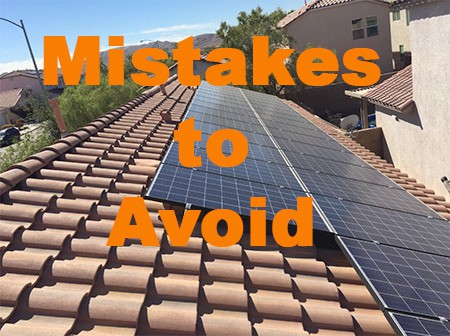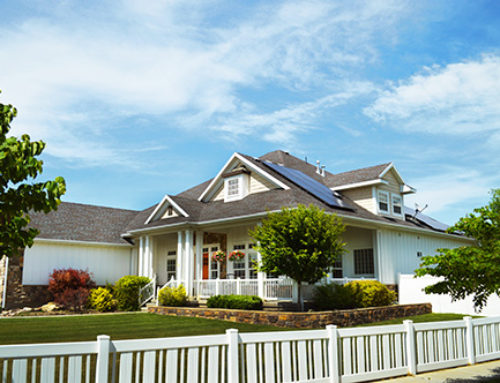So… What are the top 7 mistakes to avoid when switching to solar energy?

As the price of electricity continues to rise, many homeowners are making the switch to lower cost solar panels this year. Solar energy is booming, thanks to the average 25-year life of solar panels that can translate into considerable savings.
However, installing solar panels is an investment of time and finances, and it is important that you do your homework to know what mistakes to avoid when making the energy switch.
Consider these seven common mistakes before you decide to make the change to solar.

1. Putting Off Buying Solar Panels
Deciding to install solar energy equipment is a big decision that can lead to additional questions and expenses. Many people waver when deciding to power home solar because of the cost, but the longer that you wait, the more savings you are missing out on receiving.
The urgency for you to adopt this type of energy is increased because the popularity of solar panels will cause current solar rebates and tax credits to be phased out sooner rather than later. This means that by the time you decide to install your own solar array, you may be too late to take advantage of these financial incentives.
While, of course, you will still reap the benefits of lowered electricity bills and more energy efficiency, receiving tax credits and other types of rebates makes converting to solar energy now even more enticing. Therefore, if you are wondering, “Is solar worth it?,” the answer is a resounding “yes.”

2. Misunderstanding Roof Installation
One of the biggest misconceptions about installing solar roof panels is that a home must face a certain direction, typically north, in order to catch the sun. This could not be more wrong, and you can choose to utilize solar energy no matter what direction your house faces.
The efficiency of solar energy equipment is such that a roof that is in the shade or that is facing a direction other than north will only lose approximately 10 to 15 percent of optimal solar energy production. With such a small loss for what is considered a “less-than-ideal” roof installation site, using solar is more than worth the investment.

3. Not Getting Multiple Quotes
No matter what kind of service you buy, you should always get multiple quotes before you purchase and switch to solar energy. Some unscrupulous services will charge you four times what the panels and installation should cost, losing money from your investment and time that you could be saving energy.
Therefore, get estimates from multiple companies. Have these businesses break down for you each part of the power home solar costs so that you understand exactly what you are paying for and exactly what you are getting. Make sure that each potential installer takes into consideration an evaluation of your roof, the orientation of your home, and your current electricity bills in the estimate of solar system size and installation costs.
Of course, no two installers will provide estimates with identical itemized costs, but the more specific you are in your request for information, the better you will be rewarded with clear cost lists when you receive the estimates.

4. Buying Cheap Solar Panels
You are probably considering the switch to solar because of the potential for money savings. However, saving money on the type of solar array that you install is not the place to cut corners. Remember that buying cheap solar panels may seem like the right idea now, but the short-term savings will cost you more money in the long run when you have to replace faulty or broken system parts that failed too quickly.
This does not mean, however, that you have to buy all the best solar batteries and that you need to ignore small solar cells because the bigger ones must be better. Unless you have become an expert yourself and you know how big is a solar panel that is best suited for your home, this is where the advice of a professional installer who you can trust is invaluable. Your chosen team will help you determine whether you need big or small solar cells, how to add any necessary roof support, and what are the best solar batteries for your project.

5. Ignoring Rebates and Incentives
As you know, a solar panel system for a house is not particularly cheap, but it is a long-term investment. With a price tag of around $15,000 to $30,000, converting to solar energy requires commitment. However, there are typically tax credits, rebates, and other incentives available in each state that can help you get that cost way down.
In fact, the United States government encourages homeowners to invest in solar power, offering different methods through the Department of Energy to shave the price down sometimes as much as 30 percent from a combination of federal, state, and even local incentives. In addition to these readily available discounts, you should also consult with your local utility company, which may be offering rebates for your reduced monthly bills based on the efficiency and on the life of solar panels.

6. Thinking You Can Do It Yourself
If you are the type of person who likes to do things yourself, especially if you see it as a means for saving money, you may be tempted to install the solar energy system yourself. However, do you know how big is a solar panel? Do you know how much roof support such a panel might need? Do you know how to complete solar panel wiring?
If you do not know the answer to any of these questions, you should leave the installation to the professionals. You do not want to make a mistake on the installation or the solar panel wiring that can lead to damage to your home or problems with your energy use. Make sure that you get multiple quotes and that you find someone reputable to complete the project; hiring someone cheap or someone who is a friend or relative but without any experience is just as bad as doing it yourself.

7. Having Unreasonable Expectations
If you are wondering, “Is solar worth it?,” you may accidentally fall into the trap of expecting to see immediate savings as soon as you have the system hooked up and running. However, you have to remember that depending on your type of solar panel system and your average energy usage, it may take many years before you truly start to see the financial rewards of adopting solar energy.
It is important to also remember that the sun is uncontrollable and unpredictable. Your solar energy system’s output could vary from day to day and from season to season depending on the number of daylight hours and the amount of cloud cover your area experiences.
Therefore, you must have a reasonable expectation for how long the payback period will last before your investment pays for itself. Day-to-day variations in energy usage and savings is normal. Think of your solar energy project investment like an investment in the stock market; some days it will be better than others. That is why you need to do your homework and make sure that you understand what you can truly expect in return for your investment.
Choosing to convert to solar energy is a good idea for the environment and for your wallet. However, you must go into the process of switching with your eyes open. As you get ready to embark on this change, remember these seven common mistakes, and avoid them.
